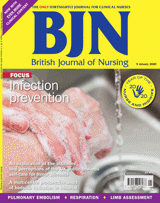References
The role of the healthcare environment in the acquisition of infection
Abstract
The maintenance of a clean environment is a fundamental principle of infection prevention and control (IPC) and every patient deserves to be treated and cared for in a clean, safe environment. In recent years, a contaminated healthcare environment has been considered by some IPC practitioners to have a role in infection acquisition, but the development of any infection is complex and will depend on a number of variables (Boyce et al, 2010; Dancer, 2014). Developing a healthcare-associated infection is a serious patient safety issue that not only is very costly for the healthcare setting concerned, but also greatly increases morbidity and mortality rates. Therefore, an understanding of all the modern methods to maintain IPC is necessary to provide an adequate and cost-effective service.
The extent to which the environment contributes to the transmission of pathogens and the level of cleanliness required to prevent infection is unknown. Historically, keeping the healthcare setting clean was viewed as an aesthetic measure, but today there is much debate and controversy around the benefits of a clean environment in promoting recovery from sickness and preventing infection. We know that prevention and control of infection is multifaceted, and interventions such as antimicrobial stewardship (promoting evidence-based prescribing of antibiotics) or standard and transmission-based precautions such as hand hygiene and isolation are supported by the literature. Nonetheless, when it comes to the clinical environment, its role in infection acquisition is hypothesised reactively from infection outbreak studies and pre- and post-intervention studies. Whether the general environment outside of these conditions contributes to, or is the cause of, infection acquisition is untested and therefore unknown.
Register now to continue reading
Thank you for visiting British Journal of Nursing and reading some of our peer-reviewed resources for nurses. To read more, please register today. You’ll enjoy the following great benefits:
What's included
-
Limited access to clinical or professional articles
-
Unlimited access to the latest news, blogs and video content

